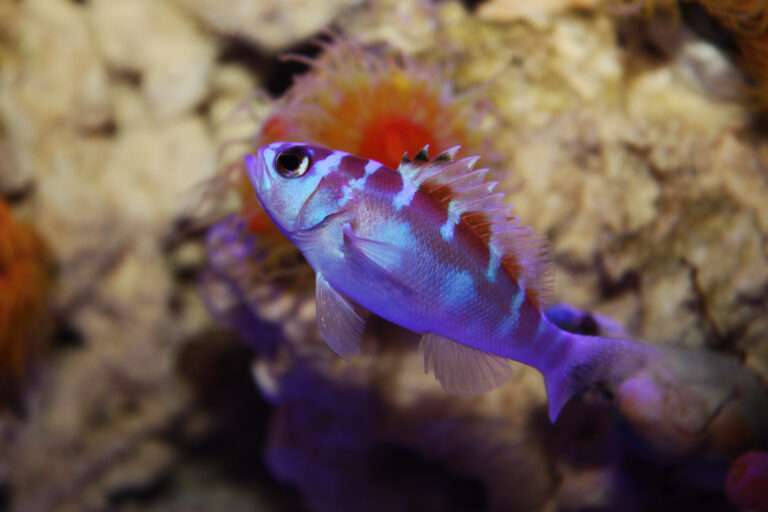
Size
The chalk bass measures 8.0 cm (3.1 in).
Physical characteristics and behavior
A sharp snout and an elongated, laterally compressed body characterize Serranus tortugarum. Three spines, with the middle one being straight, make up the gill cover. Serrated preopercle borders lack spines at an angle. The anal fin has three spines and seven soft rays, compared to the dorsal fin’s 10 spines and 12 soft rays. caudal fin with a truss. This species has the ability to change its color and pattern to blend in with its surroundings. Eight brief, vertical blue-gray bands, the first on the upper body just below the eye, the last on the caudal fin, are visible on the head and body, which range in color from light blue-gray to pinkish brown. They reach down below the dorsal fin. There is a row of one to three light dots on the clear to pinkish fins.
Habitat
Chalk Bass prefer water that is 72–76°F. pH 8.1 to 6.4 is ideal for chalk bass. Water hardness dKH 8–12 is ideal.
As Pet

- Tank Size
Get a tank that is 20 gallons in size if you only want one adult chalk bass. Chalk Basslets now prefer to live in communities. In your saltwater aquarium, you need thus house at least three Chalk Basslets if you are looking for it. A 30 gallon tank is required for that.
- Substrate
Basslets called Substrate Chalk are bottom feeders. Therefore, you need be careful to select the proper type of substrate for your fish. For your Chalk Bass tank, it is advised that you use sand because it will replicate the fish’s native reef environment. Make careful to fill the bottom of your tank with a lot of rock debris. These not only make your fish more at ease and relaxed but also enhance nitrogen cycling
- Ornaments
Don’t forget to include lots of hiding places in your tank if you want to catch a chalk bass. If you can effectively replicate their natural environment inside the reef tank, these fish will feel at home. Your aquarium should have living rocks, caverns, stones, coral fragments, and conch shells.
Places to hide enhance the sense of being at home. These will soothe your fish and aid with stress management. When they feel threatened or uneasy, they can quickly find cover. Additionally, these decorations will raise the appeal of your reef aquarium.
Luminous Chalk Basslets linger at the tank’s bottom. Therefore, it makes sense to choose dim illumination when introducing the fish to your tank in order to mimic their natural habitat. They’ll feel safe and at ease as a result, thanks to this.
- Light
Again, only when the lighting intensities are altered can one see the brilliant and iridescent coloration on a Chalk Bass’s body. Depending on the illumination and the angle at which the sun’s rays strike their bodies, the colors of their bodies will change. So, certainly, as your pet fish begins to adjust to the new habitat, gradually raise the light intensity if you want to fully appreciate your Chalk Bass’s beauty.
- Water Temperature
Water temperatures between 22 and 26 degrees Celsius are ideal for chalk bass growth. Make sure the water doesn’t change temperature by more than 2 degrees.
To ensure that you are correctly maintaining and managing the water temperature inside the tank, you should install a high-quality heater and an aquarium thermometer.
- pH Value
The pH level for a Chalk Bass should be kept between 8.1 and 8.4. The pH of the water must be slightly alkaline for chalk basslets to survive. You should make sure that the pH in your tank is kept at the proper level at all times.
- Hardness
For a chalk bass, water hardness should be regulated between 8 and 1 dKH. Make sure you are keeping an eye on the water’s hardness because even a small variation will make your fish uneasy.
- Particular Water Gravity
Maintain your saltwater tank’s specific water gravity between 1.020 and 1.025. Chalk basslets are bottom- to mid-level dwellers.
- Diet
Chalk Basslets have a reputation for stealing food from fish that swim slowly. Make sure the food is distributed throughout the tank in various amounts to avoid this. You can give them food: Algae, Bivalves (chopped), Crustaceans (chopped), Shrimp, krill, squid, and fish flakes from Mysis.
Table





